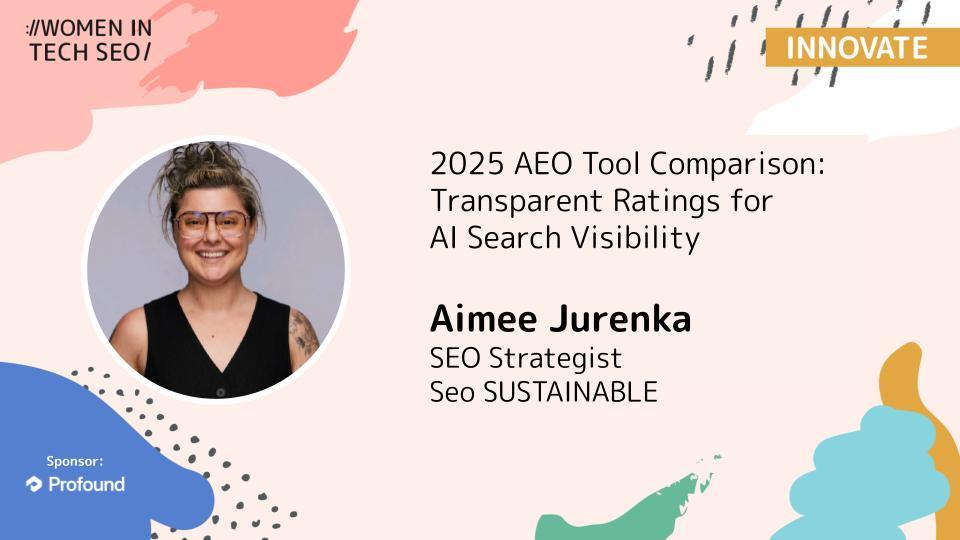👕 WTSMerch now available
🎟️ WTSFest 2026 tickets on sale for London, Portland, & Philadelphia
👕 WTSMerch now available
🎟️ WTSFest 2026 tickets on sale for London, Portland, & Philadelphia

Author: Aimee Jurenka
Last updated: 29/07/2025

In 2025, the SEO landscape no longer begins and ends with ten blue links. With generative answers now showing up before traditional SERPs and LLMs like ChatGPT, Claude, and Gemini becoming users’ first stop for search us SEOs are facing a critical new question:
“How do I get my brand into the answer?”
That’s the work of Answer Engine Optimization (AEO), a fast-emerging field focused on optimizing for systems like ChatGPT, Perplexity, Gemini, and Google AI Overviews.
But which tools actually help you track, measure, and improve AI visibility? Which ones are transparent, useful, and future-proof?
This guide compares 15 leading platforms using a 48-point research-backed scorecard so you can choose with confidence.
To help SEO professionals and marketers assess which GenAI tools are truly built for AI-powered search, I developed a transparent, evidence-based scorecard.
Each tool is scored out of 48 possible points, across five core categories, each with specific sub-criteria.
To bring clarity to the growing AEO tool market, I evaluated each platform using a five-part framework designed to reflect real-world use cases for technical SEOs, strategists, and content teams.
Each tool is scored across five categories, based on publicly available information, product documentation, and platform demos.
1. Coverage
Max points: 9
Measures what the tool does:
2. Confidence
Max points: 9
Measures if it clearly explains:
3. Fit for AI Search
Max points: 9
Measures AI search optimization:
4. Market Trust
Max points: 9
Measures trust & longevity:
5. Buyer Fit
Max points: 12
Measures who is the tool built for:
Each sub-criterion is rated from 0 to 3:
Profound - 40 / 48
Enterprise-level AI visibility & analytics
XFunnel - 40 / 48
Full-funnel experimentation & optimization for agencies/enterprises
DemandSphere - 38 / 48
Deep coverage tracking for AI + SERP visibility
AthenaHQ - 38 / 48
Data-driven brand teams & AI strategy
ZipTie.dev - 37 / 48
Freelancers, SMBs, SEO + AEO diagnostics
Conductor - 35/48
API-powered AI tracking for enterprise teams
Rankscale - 35 / 48
Fast auditing, credit-based usage model
Ahrefs Brand Radar - 34 / 48
Teams already invested in the Ahrefs ecosystem
Writesonic GEO - 34 / 48
AI visibility + integrated content workflows
Knowatoa - 32 / 48
Solopreneurs and agencies
Waikay - 28 / 48
Cost-sensitive SMBs or independent consultants
Peec AI - 27 / 48
Mid-tier prompt benchmarking
(X)OFU - 26 / 48
BOFU inclusion tracking & citation analysis
Otterly.ai - 26 / 48
Basic prompt research & brand monitoring
Gumshoe AI - 25 / 48
Persona-level brand visibility

AI search visibility tool comparison of power and trust
To get a visual of what these scores mean for the power and ability of each tool as well as the trust and accessibility of the tool, we created a visual that combines and normalises the scoring categories in order to plot them.
Power scale
This is made of the 3 categories that help us understand what the tool is capable of, documentation, and features:
Trust scale
This is made of the 2 categories that help us understand the tool's cost vs value, longevity, and who it's built for:
Score: 40/48
Strengths: Unmatched breadth- tracks brand mentions, citations, AI crawler logs, shopping visibility, and prompt trends. Best for agencies and enterprise teams.
Watch for: Steep pricing for solos, some gated documentation.
Score: 40/48
Strengths: Offers funnel visibility, segmentation, hallucination detection, and experimentation playbooks.
Watch for: Pricey for individuals; best suited to multi-brand management.
Score: 37/48
Strengths: Great balance of AI + traditional SEO diagnostics. Affordable and transparent.
Watch for: Lacks deeper prompt insights or LLM integrations.
Score: 38/48
Strengths: Built by ex-Googlers, with advanced sentiment analysis, prompt tracking, and enterprise integrations.
Watch for: Not self-serve; pricing starts at $270/mo.
Score: 34/48
Strengths: Combines AI visibility with actionable writing + optimization tools. Starts at $16/mo.
Watch for: Limited e‑commerce support.
Score: 38/48
Strengths: AI + SERP hybrid tracking with localization and BigQuery integration.
Watch for: Pricing opaque; not ideal for freelancers.
Score: 35/48
Strengths: API-powered tracking across AI platforms like ChatGPT and Gemini enables highly accurate brand visibility insights. Built for enterprise teams managing large-scale workflows, topic entity mapping, and internal governance.
Watch for: Not built for solo consultants or agencies; lacks technical AI audits and requires enterprise-level investment.
Score: 35/48
Strengths: Real-time AI prompt and answer tracking via credit system.
Watch for: No prompt writing tools; focused on tracking.
(tool in development)
Score: 34/48
Strengths: Seamless if you already use Ahrefs. Strong docs and visibility metrics.
Watch for: Lacks crawler or optimization tools.
https://ahrefs.com/brand-radar
Score: 28/48
Strengths: Lightweight, affordable, actionable fixes for content accuracy.
Watch for: Limited in scale, scope, and AI depth.
Score: 27/48
Strengths: Straightforward prompt visibility at an accessible price point.
Watch for: Lacks deeper technical insights.
Score: 25/48
Strengths: Unique persona segmentation and share-of-voice reports.
Watch for: No prompt, crawler, or technical support.
Score: 26/48
Strengths: Tracks brand sentiment, prompt queries, and citations.
Watch for: Light on documentation and integrations.
(tool in development)
Score: 26/48
Strengths: BOFU tracking is ideal for conversion-focused brands in ChatGPT-style answers.
Watch for: No pricing details or public roadmap.
Score: 32/48
Strengths: Cross-engine prompt tracking plus AI bot accessibility audits make it a great fit for solopreneurs and small agencies.
Watch for: Limited optimization tools and integrations; no e-commerce or workflow automation support yet.
The AI Visibility space is expanding rapidly. Whether you're a solo consultant or running an enterprise SEO team, choosing the right tool depends on your goals, technical needs, and budget.

AI search visibility tool by use cases
Below is a more detailed breakdown of the best-fit platforms by category:
For individual practitioners who need clear, affordable AI insights:
Agencies require scalability, multi-seat collaboration, and actionable reporting:
Agencies require scalability, multi-seat collaboration, and actionable reporting across a diverse client portfolio. The best tools in this space offer flexibility, automation, and visibility across both generative and traditional search.
Large organizations need flexibility, integrations, and compliance-ready tools:
Product discovery and AI Shopping visibility are top priorities here:
For SEOs focused on content creation and prompt-level analytics:
Perfect for teams needing to understand how crawlable and accessible their content is to AI bots:
For those optimizing brand visibility by funnel-stage, high-intent AI answers:
AEO tools are still emerging, but some are already delivering immense strategic value. You don’t need the highest score. You need the right tool for your team, your clients, and your goals.
Whether you're a solo consultant doing prompt research or an in-house lead optimizing enterprise visibility across Perplexity and ChatGPT Shopping, there’s a tool here that fits.
If you’re testing these, share your notes. If something better comes along, let’s document it together. This space needs clarity, collaboration, and exploration, and that’s what we’re trying to build here.

Aimee Jurenka - SEO Strategist
Aimee architects digital ecosystems that scale sustainably through every algorithm shift, AI evolution, and market disruption.
As an SEO, they specialize in future-proofing search visibility by integrating AI, LLM, and semantic search advancements into scalable, revenue-driven programs.
Profound helps brands win in generative search. Monitor and optimize your brand's visibility in real-time across ChatGPT, Perplexity, Google AI Overviews, Microsoft Co-pilot, Grok, Meta AI, & DeepSeek.
